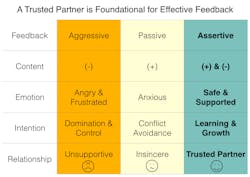One morning this past January, the Head of Operations for a bank I‘ve worked with for a few years called me in to her office. “Chris, I have some feedback I need to share with you. You said something that bothered one of the people you interviewed. So much so that they brought it to my attention…”
While I tried to maintain my composure, my mouth went dry and I felt the blood drain from my face. It took a huge mental effort for me to listen, digest and offer my perspective in a non-defensive and constructive way. That was my deeply emotional response to such a situation, and I make my living from promoting, gathering and delivering feedback. It’s no wonder feedback in an organizational context is so fraught with mixed emotions and doubts about its impact.
Feedback has been getting a fair share of bad press lately. However, in my opinion, detractors are conflating feedback (which is a good thing) with how it is delivered (which leaves much room for improvement).
Feedback is at the crux of the scientific method and is at the heart of all kinds of human endeavors. For example, the Apollo 11 spacecraft deviated from its target 99% of the time. Constant feedback and adjustment against the desired course enabled the astronauts to ultimately land a man on the moon. Today, Formula One cars’ telemetry systems transmit thousands of data points per second back to computers and engineers so they can tune the engines and other components in real time to maximize performance.
With organizations and individuals, positive change begins with awareness. Feedback is essential for building that awareness. For example, videos of our performance are essential to improving our presentation skills. Engagement surveys inform our efforts to create better places to work. Individual feedback helps us make better decisions and become more effective leaders. The problem that people usually have isn’t with the feedback itself, but how it’s delivered.
Think of someone who has had a tremendously positive impact on your life. Odds are they guided you in a careful and loving way. That’s feedback done right because, at its heart, it arises from a trusting relationship. Now think of the leaders and managers you’ve worked with, and around, who were always critical, even contemptuous, showing little regard for your development and well-being. What was the impact and ultimate value of their feedback?
Feedback can do both harm and good. It’s no surprise that Kluger and DeNisi’s seminal review of 131 studies found that over a third of feedback interventions actually decreased performance. And while Bridgewater’s widely reported practice of “radical transparency” underpins the success of its investment portfolios, it also comes at a cost of losing over a third of its talented first-year hires.
All communication conveys three components; the information, the emotion and the intention. All three are affected by pre-existing relationships. What is communicated and how it is perceived are determined by the nature of this relationship.
While supportive and growth-oriented communication techniques are helpful when delivering feedback, the paranoid tendencies of our limbic brains will pass everything someone says through a ‘friend or foe?’ filter. That’s why delivering feedback that will be effectively received requires more than communication tips. You need to be experienced as a trusting partner
First, let’s look at the issue of information accuracy. I disagree with recent criticisms that manager and peer feedback is subjective, generally unreliable and more distortion than truth. People can offer fact-based and constructive feedback. There are reasons why we seek out good doctors, mechanics, and consultants for the best diagnosis and recommendations. Tapping into the insights from co-workers with firsthand observations of our behavior can be very illuminating.
Another recent criticism is that we should avoid negative feedback altogether because it impairs learning. As a lifetime executive coach and keen competitor, I find this claim to be plain wrong! Personally, I would be very frustrated if my coaches did not point out my shortcomings and help me focus on improvement. What’s necessary for delivering effective feedback is not whether its positive or negative; it’s whether we trust the source, and whether we want to learn and get ahead. Most people do.
Interestingly, a new paper, The Relative Value of Positive and Negative Feedback, shows that higher levels of workforce engagement are related to higher levels of both favorable and unfavorable feedback. According to this research, higher unfavorable feedback is better for employee engagement than no feedback. This contradicts the popular thinking and movement that we should help people excel by maximizing their strengths and overlooking their weaknesses.
While much of the attention to effective feedback focuses on getting the information right, we know that ‘being right’ is only a small part of a helpful improvement-oriented dialogue. Accurate observations from someone who doesn’t care about you often comes across as hurtful aggression, which is more likely to cause damage than help. A trusting relationship ensures that factual performance observations will be constructively received.
Trust isn’t a one-way street either. Positive intentions are pivotal both for both the feedback giver and receiver. For feedback givers, the intention needs to support the receiver’s learning interests. That’s why givers need to first find out what receivers are interested in, and then to try to support them in realizing their goals, not just our own. On the flipside, feedback receivers need to identify and share their aspirations, and ask for input and guidance in how to achieve them.
This is very much in line with the recommendations of executive coach Marshall Goldsmith based on his experience working with over 5,000 leaders. His guidance is that after a 360-degree feedback exercise, recipients should decide what they are committed to improving, share these goals with colleagues and seek their suggestions for what to change in the future. He calls this ‘feedforward.’ On a relevant and more personal note, I always appreciate it when my guitar teacher asks me what I want to work on, before offering me any guidance.
An underlying relationship built on trust is what made my experience with my client’s direct feedback so powerful. She was not just informative and honest; she also demonstrated her support by speaking to our shared interests and acknowledging the nuance of the situation. While the experience was unsettling, it caused me to reflect. I became aware of something I didn’t realize, which caused me to seek others’ counsel, and I learned. Additionally, my loyalty and respect for this person has deepened, and I greatly look forward to continuing to work together.
Chris Morgan is a Partner at Morgan Alexander an executive coaching firm, and co-founder of Listentool a real-time feedback application.
About the Author
Chris Morgan
Founder and Principal
Based in the San Francisco Bay area, Chris Morgan is founding principal of Morgan Alexander, a consulting firm that coaches senior management teams to lead winning organizations, and co-founder of ListenTool. He is one of a few executive coaches with more than 20 years of experience, having started with The Alexander Corporation. Morgan’s clients are primarily CXO engagements with Fortune 500 companies, and high-tech startups in the San Francisco Bay area.

